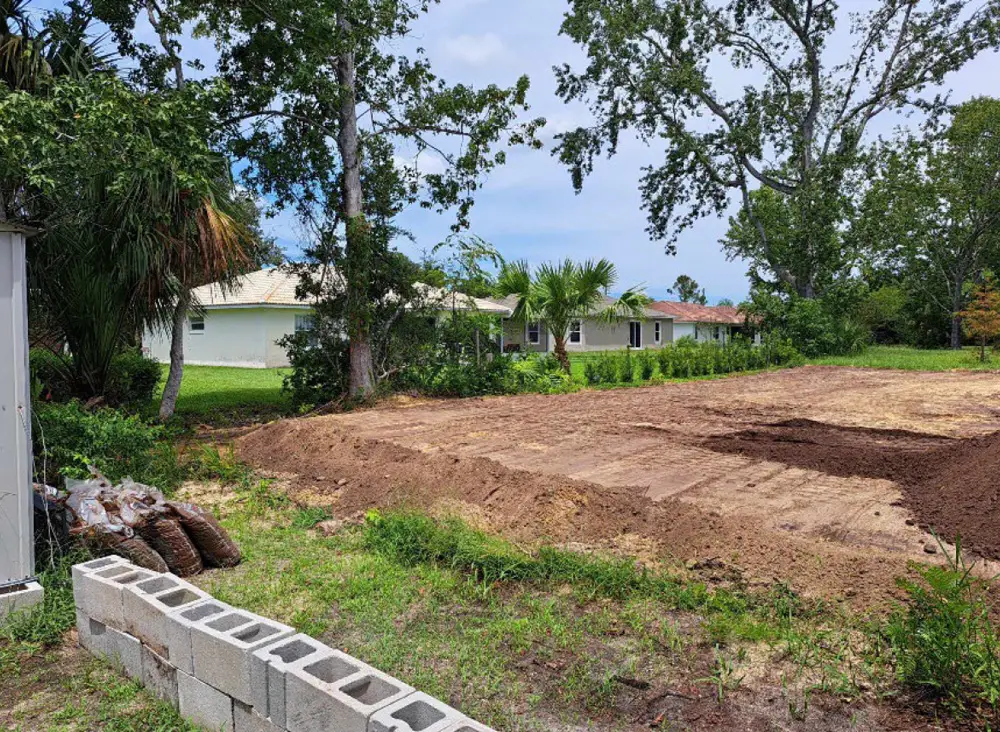
Note: this is one of two articles on this subject today. See the other: “City Attorney Warns Palm Coast Away from Financially Aiding Flooded Property Owners.”
![]()
There are all sorts of reasons many of Palm Coast’s front and back yards are flooding the more new homes go up, up and up. But builders and new construction are not the reason. That’s the first conclusion from an analysis presented to the Palm Coast City Council this morning.
The second is that the city is on it: staffers are working with the more than 80 property owners who have lodged complaints to date–not as fast as the city wishes it could, with just a quarter of those complaints answered so far, but steadily, and intently. The third is that the city is rewriting its technical building manual directly to address new-home elevations and drainage issues in hopes of blunting further problems of the sort, or at least diminishing them.
Less clear is how the city intends to help residents already affected by yard flooding beyond providing them with survey analyses and engineering suggestions. In other words, while the city is prepared to rewrite its building rules and explain to residents why their front or back yards are flooding, and what they could do about it, the city is not ready to go beyond that–and it’s not clear whether it should, or legally can–though at least one council member wants to head that way.
The analysis presented to the City Council this morning was the most thorough on the flooding problem since it emerged, first in a trickle of complaints a few months ago, mainly to local media, then in a flood of them before the City Council, prompting an upending of city priorities (or a “pivot,” in City Manager Denise Bevan’s Ross Geller-inspired reference) to those particular residents’ concerns.
Carl Cote and Lynn Stevens, the director and deputy director of stormwater and engineering, gave a lucid explanation of what amounts of the bubbling up of unintended consequences that brought residents in drove before the council with complaints.
There were 47,500 quarter acre lots when ITT designed and platted Palm Coast in the late 1960s. Four-fifths of those lots are now built up. That still leaves
“a little under 10,000 vacant lots,” Carl Cote, the city’s stormwater and engineering director, said.
When new homes go up on those lots–what the city calls “infill” lots, because the developments are “filling in” mostly developed land, as opposed to sprawling beyond it–all sorts of discombobulating variations occur. It’s as if Palm Coast were made up of 47,500 little tectonic plates. Past and present building codes clash. Past and present topography clash. Past and present vegetation clash. And of course current residents and new builders clash.
ITT had decided to have very flat lots, with typically an inch and a quarter drop from one side of the lot to the other, on an 80-foot lot. It was intentional, to allow for a very slow percolation into the ground to recharge the aquifer. ITT also designed a lot of built-up lots to drain onto vacant lots. That, too, was either by design or by gravity. “A lot of natural ground compaction has occurred over time, you figure some of these houses are 20-30 years old,” Stevens said. By compaction, she means that houses have settled, or sunk in. And like Palm Coast’s own subduction zones, older houses have gone down, newer houses, and newer regulations, have gone up. “There’s been a lot of changes in the residence elevations as well from from what was originally built.”
“Some of the existing homes are now retaining their own stormwater that used to run off to the vacant lots,” Stevens said, repeating a contention city staffers have made a few times over the past few weeks: the water pooling in existing lots may not be coming from adjacent, newer, higher construction. The removal of trees and roots, it causes the ground to compact, and settle more. Conversely, as trees grow, their roots grow, their surroundings lift. Re-sodding can change the elevation. Road elevations can change from one block to another: one road could be a foot higher than another, parallel road, which changes the house elevation at one end as opposed to a house at the other end. In some places, the water table can be just a few inches below the surface, which dictates how water flows and how quickly it moves away from homes.
That’s the diagnosis of why lots are flooding. As to what the city is doing to help residents: The city designated a specific category for infill lot drainage problems through Palm Coast Connect, the city’s web-based problem-solving portal enabling residents to file complaints and follow the progress of their case. The city has registered 83 such cases so far. City engineers and staffers have been out to 21 properties. In one case, they found a difference of 16 inches from one home to the next. “That’s been the worst case we’ve reviewed up to that point,” Cote said.
Read Related Also: Bodies Believed to be Missing Couple, Allegedly Killed by Angry Tenant, Found at Military Base
Once a complaint is received, there’s an automatic response then a site visit scheduled. “We spend some time with the resident, we review what the issues are, what their complaints are, how long it’s been happening, how long does the water stay behind. We have a host of questions that we ask to gather information from the resident themselves to fully understand the issues,” Lynn Stevens, deputy director of stormwater and engineering, said. The staffers also analyze surrounding properties then study surveys, some of them more complicated than others if they go back to the 1990s or before. (The first homes in Palm Coast went up in 1969.) They measure elevations in some cases, but mostly rely on licensed surveyors’ documents.
The stormwater department handles some 100 work orders at any one time, in addition to the infill drainage cases–permit-generated inspections of walls, driveways, swales, and so on. “So we have not gotten to as many of these cases as we would like to, to do the site visits but we are working diligently on that and setting time aside each week so that we can spend a day just doing these types of cases,” Stevens said.
“Time is of the essence so I would expect you to go to city manager with whatever requests you deem are essential to complete this data collection as quickly as possible,” Mayor David Alfin said, though Bevan has been getting regular updates as it is.
Beyond that, the re-write of regulations to address the long term. The city’s technical manual was already under review when the controversy exploded five weeks ago. The city has since made the re-write a more urgent priority.
There were no lot grading reviews by the city until 2004. There was no maximum fill elevation set–at least not explicitly so. But as Cote explained, to say that a house could rise as high as a builder wanted it to rise would be false, because another regulation had the same effect as setting a fill height limit: Grading is restricted to a four-to-one slope. A house built on 3 feet of fill would not have the space, in a quarter-acre lot, to slope down within that restriction. Therefore, it couldn’t be built that high.
But in the new regulations, the city will set height limitations anyway, just to make it explicit. The Florida building code also requires all grades around a house to be four inches below the finished floor for block houses, and 6 inches for wood structures. And as you grade away from the home, it must drop 6 inches in the first 10 feet, and from there, it must maintain a 2 percent slope. That’s not changing.
The proposed change in the city’s technical manual: maintain the floor elevation of new homes at a minimum required height of 12 inches–a foot–over the crown of the road in front of the house (all streets are curved downward from their center, the center being the crown), with a maximum allowed of 22 inches. But there may not be more than a 10-inch difference between the floor elevation of one house and that of any house adjacent. In other words, if existing homes that have been built at different standards and that have settled into the ground are even with the crown of the road, the new house adjacent will not be allowed to rise more than 12 inches from the crown. If a house is 5 inches above the crown, the new house would not be allowed to be more than 15 inches above the crown, unless there are extenuating circumstances approved by a licensed engineer.
Also, the front property line will be established at the edge of the road, not the crown of the road, which reduces the grading from the front of the property by up to 6 to 8 inches, thus reducing the future elevations of homes.
The city circulated its proposed changes with home builders and other “stakeholders,” and is awaiting feedback. Once formalized, all the re-written regulations will be re-circulated, as will be informational pamphlets for the public and for builders, explaining what could cause water to pool and what may be done to prevent it.
“It’s a good thing, and I’m glad to see that we’re moving as fast as we possibly can,” Council member Ed Danko said. “And I realize it’s a tedious process. So it’s going to take a little time and I asked for people to be patients.” But he wants the council to go further.
City Council member Theresa Pontieri said the technical manual’s approval should not be delayed by foot-dragging on stakeholders’ part: she wants a deadline set. “Let’s put the pedal to the metal on this and get it moving as quickly as possible so that we can stop the bleeding and then do the data gathering process that we need to do for the existing properties,” Pontieri said.
![]()
infill-lots-workshop










